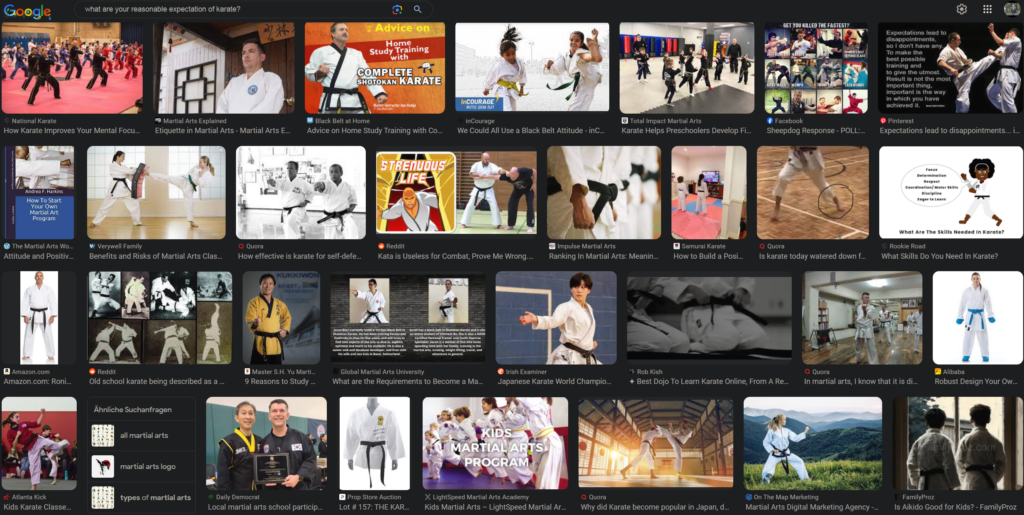Previously, I wrote about “The Four Outer Forms of Postures Discovered by Matsumura” as described and taught by the late Kinjō Hiroshi sensei. These Four Outer Forms are the result of Kinjō’s inductive reasoning and empirical argumentation. Obviously, in Okinawa karate history and technique, most of the time there is no proof in sense of “examples of exhaustive deductive reasoning which establish logical certainty.” Rather, in Okinawa karate, most often there are “empirical arguments or non-exhaustive inductive reasoning which establish a ‘reasonable expectation’.” Therefore, keep in mind that the article on the Four Outer Forms is just a snapshot and is the result of Kinjō’s lifelong search and complex derivation. It is therefore difficult to understand it’s derivation without knowing and understanding the various empirical and analytical details that led to it.
After publishing the article, I received various tips and explanations from students of Kinjo’s school about the meaning and practical implementation of the Four Outer Forms. This includes videos with dedicated instructions on the matter. All of them not only make a lot of sense and are convincing, but also show how Kinjō put his interpretation of Suidī’s technical characteristics to practice. Within the limits of his research object, Kinjō’s deduction is logical and coherent, and can be used for the practical interpretation of karate.
As a side note, he also dispels a lot of myths prevalent in modern karate narratives and Kinjō’s book is requisite material in modern karate research. The following is a translated excerpt.
Within the limits of the literature explored so far, there is no positive proof of an indigenous combat sport in ancient Ryūkyū , but there is also no evidence that there was not.
Some say that in the 1300s, because war dawned during the Era of the Three Kingdoms (Sanzan), bare-handed hand-to-hand combat sprang forth and further developed, but I disagree with this theory. As we have seen previously in the history of Chinese kenpō, prior to empty-handed fighting, mankind already had the intellect of using objects for combat. The logic that it was war that allowed for the development of bare-handed combat sport can also greatly doubted.
In group conflict, empty-handed arts are exceedingly inefficient. In the wars of ancient times as well as in modern war, although their scales and contents are completely different, there is no difference in that empty-handed martial arts are completely futile on the battlefields. Having experienced military service myself, I have this strong impression through my own experience. War, while encouraging the development of weapons, by no means contributes to the development of bare-handed hand-to-hand combat.
From the above considerations I cannot agree with the theory of the birth and development of Ryūkyū kenpō during the Era of the Three Kingdoms.
Returning to Matsumura Sōkon, from the information Kinjō had gathered throughout his life, he created an outline of the fundamental principles of the techniques of Suidī, albeit noting that “the specific contents were not handed down.”
As regards the background and process of the birth of Suidī, Kinjō describes Matsumura Sōkon as a pragmatist who was dissatisfied with the repetitive practice of conventionalized kata adhered to in Chinese kenpō, and he was also dissatisfied with the monotonous practice methods of Jigen-ryū, which did not involve leg work.
Like this, in a very abbreviated manner, Kinjō defines the fundamental principles of Suidī as created by Matsumura Sōkon as thus:
- Prefer speed above anything else.
- Use fast footwork to capture moving objects.
- There is a total of four outer forms of postures.
- Attack the opponent from the outside.
- The principles of procedure of torite.
- In your fighting posture, use your rear hand to control your opponent’s attack, and use your front hand to counterattack. Defend and counterattack in one move.
This sounds like a reasonable expectation of what Matsumura might have improved to create Suidī. There also remain a number of questions. For instance, when did Kinjō begin to claim torite? In the 1950s, when he was editor of Monthly Karate-do magazine, he didn’t mention torite at all. Therefore, seemingly, he didn’t know about it back then.
Just like this, it is a characteristic feature of Okinawa karate kobudō that it relies heavily on “reasonable expectations,” and these expectations cumulate over time.
© 2023, Andreas Quast. All rights reserved.

